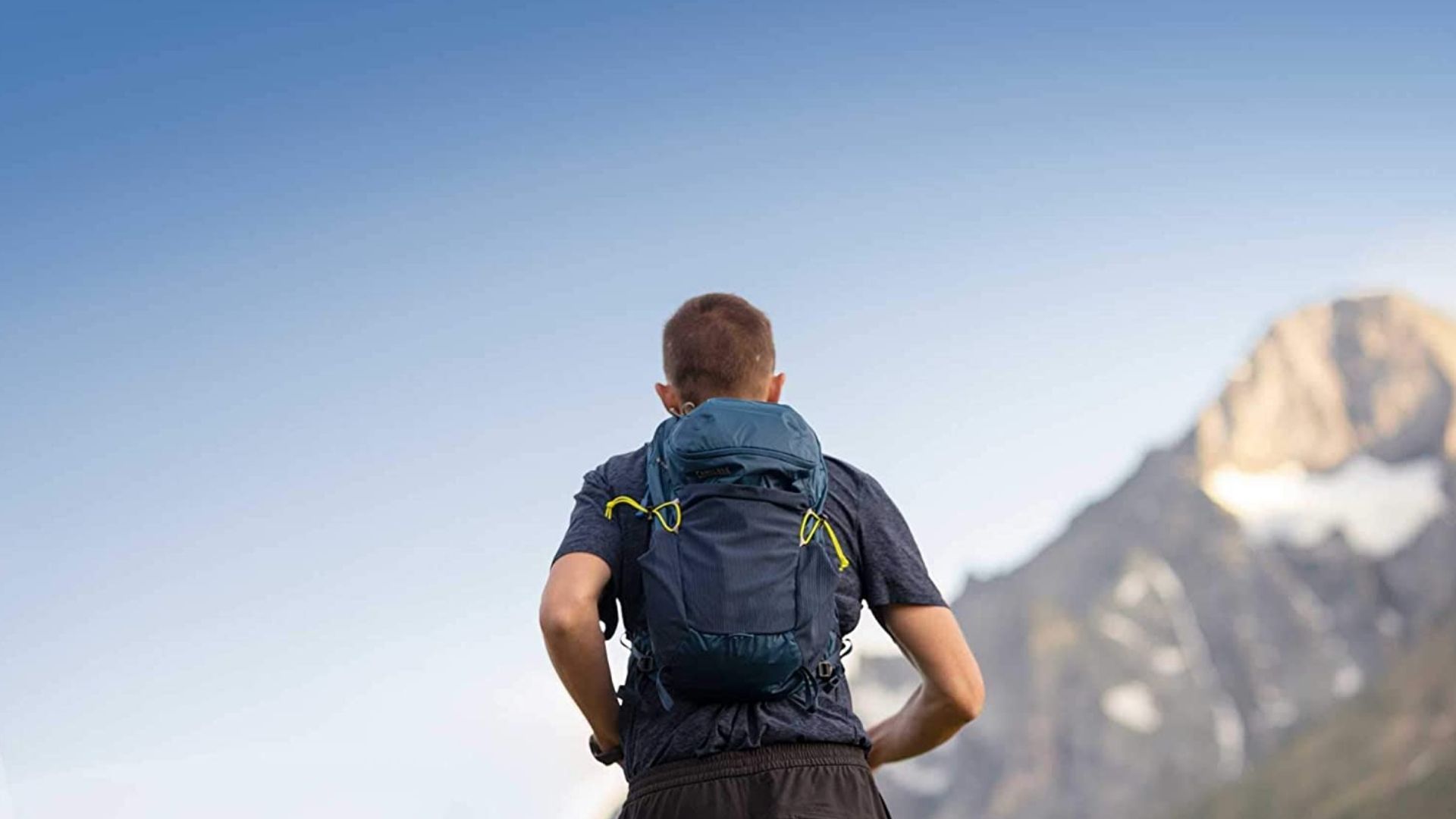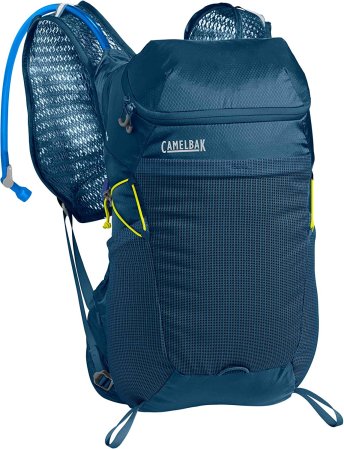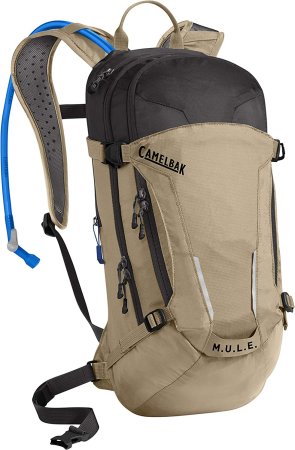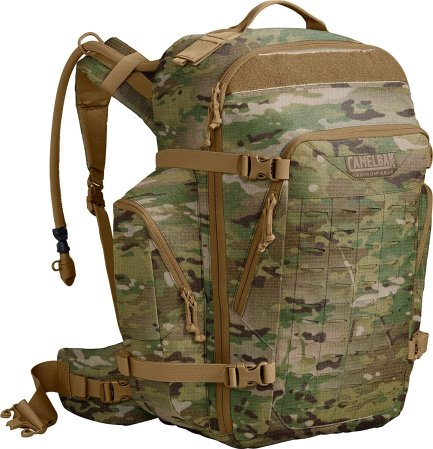

We may earn revenue from the products available on this page and participate in affiliate programs.
According to doctors, most of America is in a fight for its life with dihydrogen monoxide, and those who spend extended periods of time outdoors find the war against dehydration reaching new levels of intensity. Water is heavy, and the human body needs plenty of it to thrive. Enter the CamelBak. Like the M1 Garand in World War II, this hydration system is an elite, life-saving system for which there is no substitute. When operating out in the field, a CamelBak is absolutely essential. Its high-capacity water reservoir secures all that life-giving liquid close to your back, giving you maximum mobility with minimal drag.
Whether you need to scale a cliff, fast-rope out of a helo, or shred a backcountry mountain bike trail, don’t waste time pondering how to secure a puny water bottle that may or may not be along for the ride. Make like a camel, and keep your water on your back.
Best Overall CamelBak: CamelBak Octane 18
Best Value CamelBak: CamelBak M.U.L.E.
Best Premium CamelBak: CamelBak BFM
Best Hiking CamelBak: CamelBak Palisade 32 / Shasta 30
Best Insulated CamelBak: CamelBak Powerhorn
Related: 6 camping water filters to keep you hydrated in any clime and place
Why should you trust us
Over my years of exploring the Front Range and Sangre de Cristo mountains of Colorado, I’ve learned that dehydration can pound you harder and faster than a sledge hammer driving a nail into loose dirt. When I learned that about 75 percent of Americans are chronically dehydrated, I thought I’d take some time and help spread good cheer and hydration for all. Do I know outdoor gear? Sure do. Check out my guides for bug out bags, hiking boots, and pocket knives to see for yourself.
Types of CamelBak products
Sport-specific
The CamelBak brand got its start when EMT Michael Eidson jerry-rigged an IV bag, hose, and crew sock to keep himself hydrated during a grueling summer Texas bike race. To this day, CamelBak makes biking-specific hydration packs, but it has expanded its line to provide other sport-specific packs. The company now specializes in solutions for biking, hiking, and snow sports. While bikers and runners may need a minimalist CamelBak to achieve top times, skiers and snowboarders will opt for a pack with proper insulation for both the reservoir and hose. Find your niche, pick a pack, and get moving.
General purpose
Some people need a hydration pack that can handle more than just one sport at a time. There’s a solution for you too. In addition to its sport-specific offerings, CamelBak has created a handful of general purpose and multi-sport options designed to keep you hydrated, geared up, and on the go.
Tactical
Yeah, yeah, everyone’s got something tacticool these days, but CamelBak’s tactical hydration systems may just be worthy of the “tactical” name. While the Army may not endorse CamelBak systems, their stamp of “OK” does show that the big brass may have finally figured out what we already knew. While anyone can slap MOLLE onto a bag and call it a day, CamelBak makes sure that their bags provide the features and quality America’s grunts have come to expect from quality field gear. So, next time the lieutenant gets lost, you’ll be ready for it.
What to look for when buying a CamelBak
Reservoir capacity
Some shred bike trails at maximum speed, while others pound foot paths for hours on end. Everyone moves at their own pace, and having the right amount of water depends heavily on your chosen activity and speed. Short-term and low-speed activities may require a small reservoir capacity, but when you climb mountains everyday, you’ll want a pack with plenty of space for the water you’ll need.
Cargo capacity
Choosing a CamelBak requires consideration of more than mere hydration needs. Need a hydration pack for next weekend’s day hike? There’s a CamelBak for that. Preparing to ruck from now until December? CamelBak’s got you covered. Want a lightweight and minimalistic EDC option? No problem. Regardless of how many (or few) liters of cargo space you need, you can rest assured when slinging that CamelBak over your shoulder that you’ve got all the water, food, and gear you’ll need.
Fit
Each body is unique, and while one CamelBak may fit one person, it may not fit another. As such, CamelBaks come in a variety of sizes designed for different body sizes and shapes. While most mainstream packs are truly unisex designs, some ladies may prefer something made just for them, and CamelBak certainly delivers. The same goes for youth as well, making a CamelBak an excellent choice for just about any hydration need.
Comfort
Let’s face it: Water weighs a ton. As such, each CamelBak offering optimizes to minimize felt weight and enhance balance while maximizing your mobility and efficiency relative to the activity at hand. Pack capacities for both water and cargo increase the potential weight of your CamelBak, so be sure to look for a pack with a sternum strap and hip belt. Add in ample padding in all the right places, and you are good to go.
Organization
Every backpack comes with storage options, but as that number grows, so too does the need for organization. When purchasing a CamelBak, always evaluate its organizational setup. Bikers looking for easy access to a gel pack need quick-access pockets with little else to slow them down, while hikers and snowboarders need extra space for snacks, extra layers, and other essentials. Do your homework, and avoid being that one guy muttering, “It’s around here somewhere.”
The advantages of owning a CamelBak
You know who he is, that one guy who never plans for anything. He forgets his gear, slowing you down and pushing the limits of your sanity with excuses and stupid complaints. Whether that sounds like your lieutenant or that one guy from HR, you know he’s never understood the benefits of carrying your water on your back. When he starts digging in his pack for another Aquafina bottle, you’ve already hydrated, sipping your water on occasion as you forge ahead. When you stop for a quick rest, his bottles and gear scatter all over the trail, and while he’s cleaning up, you’ve already dismounted your own pack, grabbed a snack, and thrown your CamelBak back over your shoulder, ready to move forward. You look up at the slope above you, and already, you can feel the hand and toeholds. You could tackle that incline with ease thanks to your water and gear being right where they should be. But he can’t, because he doesn’t. Too bad your CO would miss him.
Pricing ranges for CamelBaks
When it comes to hydration systems, CamelBak instantly comes to mind, but for some, so does the price tag. While CamelBak may not be the cheapest brand on the market, its reputation for quality and activity-appropriate extras makes it worth the extra cash. Smaller packs with around 10 liters of cargo space or less may come with a reservoir anywhere between 1.5 and three liters. These CamelBaks tend to run anywhere between $50 and $100, making them an affordable option for most low-key users. Those looking for packs with a medium to large cargo capacity will find plenty of options between $100 and $150, virtually all of which come with either a two- or a three-liter reservoir. Serious outdoor adventurers looking for a virtual cavern for their cargo and two to three liters of reservoir capacity can expect to dole out over $150 for the right pack.
How we chose our top picks
We much prefer to go the hands-on route when reviewing gear, but sometimes, a lack of resources may thwart our attempts to get our mitts on some cool gear. To make sure we don’t let you down, we listen to those with firsthand experience, combing through Amazon reviews, professional publications, enthusiast blogs, and more to bring you the best intel available. We sort out the diamonds, and toss the rest.
For this buyer’s guide, we found the insight provided by the folks at Kofuzi, Singletracks and REI to be very helpful.
Related: Stay high and dry with the best waterproof backpacks




